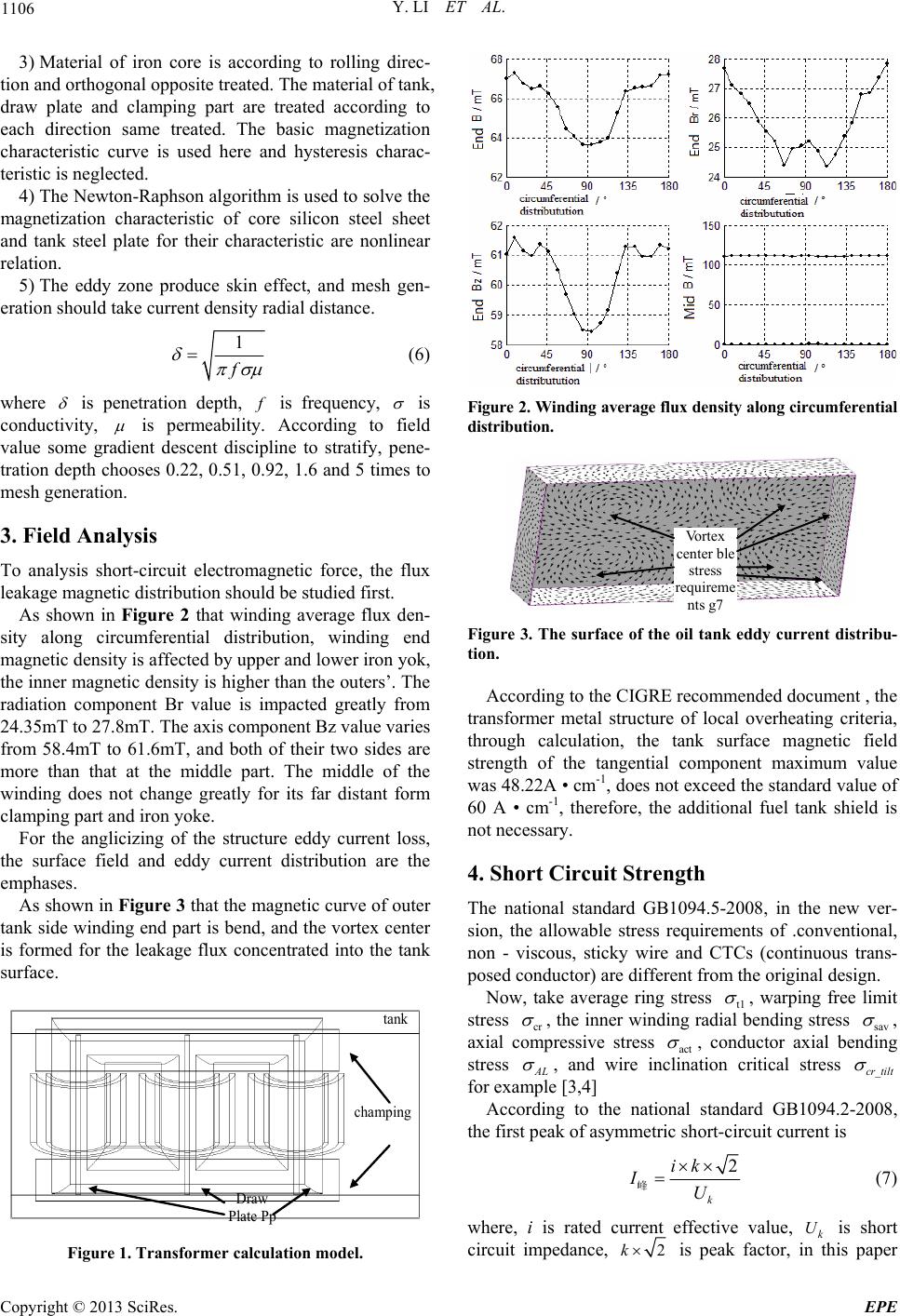
Y. LI ET AL.
1106
3) Material of iron core is according to rolling direc-
tion and orthogonal opposite treated. The material of tank,
draw plate and clamping part are treated according to
each direction same treated. The basic magnetization
characteristic curve is used here and hysteresis charac-
teristic is neglected.
4) The Newton-Raphson algorithm is used to solve the
magnetization characteristic of core silicon steel sheet
and tank steel plate for their characteristic are nonlinear
relation.
5) The eddy zone produce skin effect, and mesh gen-
eration should take current density radial distance.
1
f
(6)
where
is penetration depth,
is frequency,
is
conductivity,
is permeability. According to field
value some gradient descent discipline to stratify, pene-
tration depth chooses 0.22, 0.51, 0.92, 1.6 and 5 times to
mesh generation.
3. Field Analysis
To analysis short-circuit electromagnetic force, the flux
leakage magnetic distribution should be studied first.
As shown in Figure 2 that winding average flux den-
sity along circumferential distribution, winding end
magnetic density is affected by upper and lower iron yok,
the inner magnetic density is higher than the outers’. The
radiation component Br value is impacted greatly from
24.35mT to 27.8mT. The axis component Bz value varies
from 58.4mT to 61.6mT, and both of their two sides are
more than that at the middle part. The middle of the
winding does not change greatly for its far distant form
clamping part and iron yoke.
For the anglicizing of the structure eddy current loss,
the surface field and eddy current distribution are the
emphases.
As shown in Figure 3 that the magnetic curve of outer
tank side winding end part is bend, and the vortex center
is formed for the leakage flux concentrated into the tank
surface.
tank
Draw
Plate Pp
champing
Figure 1. Transformer calculation model.
Figure 2. Winding average fl ux density along circumferential
distribution.
Vo rtex
center ble
stress
requireme
nts g7
Figure 3. The surface of the oil tank eddy current distribu-
tion.
According to the CIGRE recommended document , the
transformer metal structure of local overheating criteria,
through calculation, the tank surface magnetic field
strength of the tangential component maximum value
was 48.22A • cm-1, does not exceed the standard value of
60 A • cm-1, therefore, the additional fuel tank shield is
not necessary.
4. Short Circuit Strength
The national standard GB1094.5-2008, in the new ver-
sion, the allowable stress requirements of .conventional,
non - viscous, sticky wire and CTCs (continuous trans-
posed conductor) are different from the original design.
Now, take average ring stress t1
, warping free limit
stress cr
, the inner winding radial bending stress sav
,
axial compressive stress act
, conductor axial bending
stress AL
, and wire inclination critical stress _cr tilt
for example [3,4]
According to the national standard GB1094.2-2008,
the first peak of asymmetric short-circuit current is
2
k
ik
IU
峰 (7)
where, i is rated current effective value, k
U is short
circuit impedance, 2k is peak factor, in this paper
Copyright © 2013 SciRes. EPE